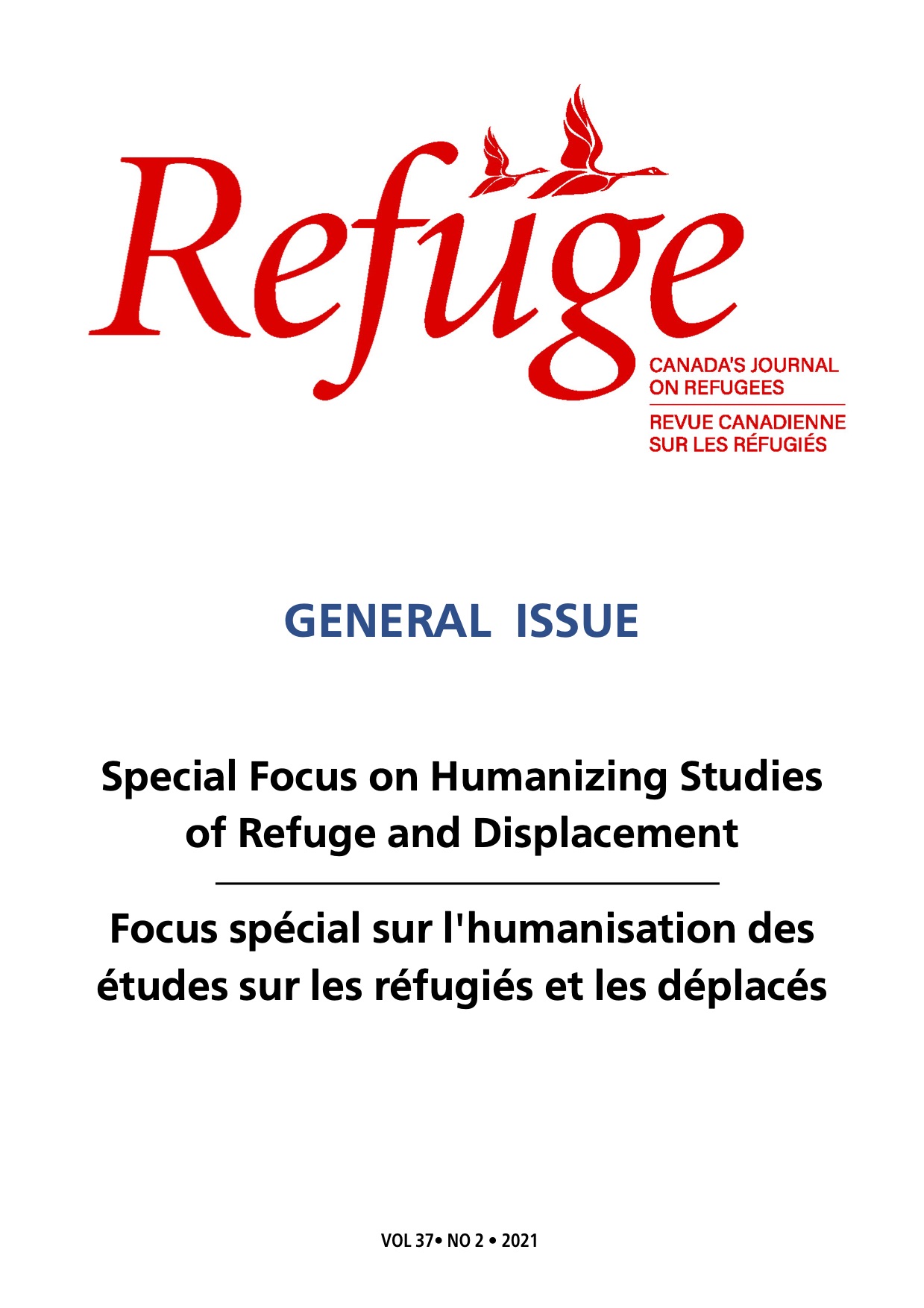Training and Integrating Public Service Interpreters in a Refugee Health Clinic: A Mixed-Method Approach to Evaluate an Innovative Program
DOI :
https://doi.org/10.25071/1920-7336.40691Mots-clés :
language barriers, refugee health, community interpreters, mixed-methods, action-researchRésumé
Les barrières linguistiques peuvent avoir un impact négatif sur la santé des réfugiés et le recours à des interprètes qualifiés est un moyen de surmonter ces barrières lors de toute forme de consultation médicale. Dans le cadre de cette étude, des interprètes ont été formés et intégrés à une clinique pour réfugiés. Des migrants de langue népalaise ont été recrutés et ont suivi cinquante heures de formation afin d’agir comme interprètes auprès de réfugiés bhoutanais récemment arrivés dans la ville de Québec. À des fins d’évaluation du projet, des données mixtes ont été recueillies. Lors de l’étude initiale et de l’étude de suivi, la santé des patient.es (telle que perçue par les praticien.nes) et leur satisfaction ont été évaluées. Les interprètes et les praticien.nes ont aussi pris part à des entretiens et des ateliers de discussion. La santé des patient.es est demeurée stable, mais, curieusement, les patient.es étaient légèrement moins satisfait.es lors de l’étude de suivi. Les praticien.nes et les interprètes ont décrit tant les bénéfices que les difficultés liés au programme. Par exemple, l’intégration des interprètes au sein de l’équipe clinique a permis une meilleure collaboration et une plus grande connaissance mutuelle des cultures. Les difficultés rencontrées incluent une surcharge de travail, des conflits entre les interprètes et les praticien.nes ainsi que des conflits de rôle pour les interprètes. De façon générale, l’intégration à temps plein d’interprètes qualifiés au sein de la clinique a facilité la communication et la gestion des cas. Cette pratique pourrait être particulièrement bénéfique pour une clientèle de réfugié.es. Dans les interventions futures, le rôle des interprètes devrait être mieux défini auprès des patient.es et des praticien.nes et une attention particulière devrait être portée aux critères de sélection des interprètes.
Statistiques
Références
Attard, M., McArthur, A., Riitano, D., Aromataris, E., Bollen, C., & Pearson, A. (2015). Improving communication between health-care professionals and patients with limited English proficiency in the general practice setting. Australian Journal of Primary Health, 21(1), 96–101. https://doi.org/10.1071/py13095
Brisset, C., Leanza, Y., & Laforest, K. (2013). Working with interpreters in health care: A systematic review and meta-ethnography of qualitative studies. Patient Education and Counselling, 91(2), 131–140. https://doi.org/10.1016/j.pec.2012.11.008
Brisset, C., Leanza, Y., Rosenberg, E., Vissandjée, B., Kirmayer, L. J., Muckle, G., Xenocostas, S., & Laforce, H. (2014). Language barriers in mental health care: A survey of primary care practitioners. Journal of Immigrant and Minority Health, 16(6), 1238–1246. https://doi.org/10.1007/s10903-013-9971-9
Catroux, M. (2002). Introduction à la recherche-action: modalités d'une démarche théorique centrée sur la pratique. Recherche et pratiques pédagogiques en langues de spécialité, 21(3), 8–20. https://doi.org/10.4000/apliut.4276
Champely, S., & Verdot, C. (2007). Que signifie la significativité statistique ? L'apport de la taille d'effet et de la puissance statistique. Staps. Revue internationale des sciences du sport et de l'éducation physique, 3(77), 49–61. https://doi.org/10.3917/sta.077.0049
Cheng, I. H., Vasi, S., Wahidi, S., & Russell, G. (2015). Rites of passage: Improving refugee access to general practice services. Australian Family Physician, 44(7), 503–507. https://www.racgp.org.au/afp/2015/july/rites-of-passage-improving-refugee-access-to-general-practice-services/
Cohen, J. (1988). Statistical power analysis for the behavioural sciences. Lawrence Erlbaum Associates. https://doi.org/10.4324/9780203771587
Creswell, J. W., & Plano Clark, V. L. (2011). Designing and conducting mixed methods research (2nd ed). SAGE Publications.
Dubus, N. (2015). Interpreters' subjective experiences of interpreting for refugees in person and via telephone in health and behavioural health settings in the United States. Health and Social Care in the Community. https://doi.org/10.1111/hsc.12270
Dubus, N. (2016). Interpreters’ self-perceptions of their use of self when interpreting in health and behavioural health settings. Refuge, 32(3), 119–124. https://doi.org/10.25071/1920-7336.40355
Dubus, N., & LeBoeuf, H. S. (2019). A qualitative study of the perceived effectiveness of refugee services among consumers, providers, and interpreters. Transcultural Psychiatry. https://doi.org/10.1177/1363461519844360
Gartley, T., & Due, C. (2017). “The interpreter is not an invisible being”: A thematic analysis of the impact of interpreters in mental health service provision with refugee clients. Australian Psychologist, 52(1), 31–40. https://doi.org/10.1111/ap.12181
Gkiouleka, A., & Huijts, T. (2020). Intersectional migration-related health inequities in Europe: Exploring the role of migrant generation, occupational status & gender. Social Science & Medicine, 267, 113218. http://dx.doi.org/10.1016/j.socscimed.2020.113218
Glaesmer, H., Wittig, U., Braehler, E., Martin, A., Mewes, R., & Rief, W. (2011). Health care utilization among first and second generation immigrants and native-born Germans: A population-based study in Germany. International Journal of Public Health, 56, 541–548. https://doi.org/10.1007/s00038-010-0205-9
Gushulak, B. D., Pottie, K., Hatcher Roberts, J., Torres, S., & DesMeules, M. (2011). Migration and health in Canada: Health in the global village. CMAJ, 183(12), E952–958. https://doi.org/10.1503/cmaj.090287
Jacobs, E., Chen, A. H., Karliner, L. S., Agger-Gupta, N., & Mutha, S. (2006). The need for more research on language barriers in health care: A proposed research agenda. Milbank Quarterly, 84(1), 111–133. https://doi.org/10.1111/j.1468-0009.2006.00440.x
Karliner, L. S., Jacobs, E. A., Chen, A. H., & Mutha, S. (2007). Do professional interpreters improve clinical care for patients with limited English proficiency? A systematic review of the literature. Health Services Research, 42(2), 727–754. https://doi.org/10.1111/j.1475-6773.2006.00629.x
Karliner, L. S., & Mutha, S. (2010). Achieving quality in health care through language access services: Lessons from a California public hospital. American Journal of Medical Quality, 25(1), 51–59. https://doi.org/10.1177/1062860609351237
Khanlou, N. (2010). Migrant mental health in Canada. In N. Khanlou & B. Jackson (Eds.), Canadian Issues: Immigrant Mental Health (pp. 9–16). Public Health Agency of Canada: Association for Canadian Studies. https://acs-aec.ca/en/publications-en/immigrant-mental-health-en/
Krupic, F., Hellstrom, M., Biscevic, M., Sadic, S., & Fatahi, N. (2016). Difficulties in using interpreters in clinical encounters as experienced by immigrants living in Sweden. Journal of Clinical Nursing, 25(11–12), 1721–1728. https://doi.org/10.1111/jocn.13226
Leanza, Y., Angele, R., René de Cotret, F., Bouznah, S., & Larchanché, S. (2020). Former au travail avec interprète de service public et à la médiation interculturelle: une étude exploratoire, L'autre, cliniques, cultures et sociétés, 21(1), 73–82. https://doi.org/10.3917/lautr.061.0073
Leanza, Y., Boivin, I., Moro, M.-R., Rousseau, C., Brisset, C., Rosenberg, E., & Hassan, G. (2015). Integration of interpreters in mental health interventions with children and adolescents: The need for a framework. Transcultural Psychiatry, 52(3), 353–375. https://doi.org/10.1177/1363461514558137
Leanza, Y., Brisset, C., Rocque, R., & Boilard, A. (2017). Challenges to and recommendations for working with a community interpreter in mental health: A Canadian perspective. In E. Jacobs & L. Diamond (Eds.), Providing health care in the context of language barriers: International perspectives (pp. 56–70). Multilingual Matters.
MacFarlane, A., Dzebisova, Z., Karapish, D., Kovacevic, B., Ogbebor, F., & Okonkwo, E. (2009). Arranging and negotiating the use of informal interpreters in general practice consultations: Experiences of refugees and asylum seekers in the west of Ireland. Social Science & Medicine, 69(2), 210–214. https://doi.org/10.1016/j.socscimed.2009.04.022
Miller, K. E., Martell, Z. L., Pazdirek, L., Caruth, M., & Lopez, D. (2005). The role of interpreters in psychotherapy with refugees: An exploratory study. American Journal of Orthopsychiatry, 75(1), 27–39. https://psycnet.apa.org/doi/10.1037/0002-9432.75.1.27
Newbold, K. B. (2005). Self-rated health within the Canadian immigrant population: Risk and the healthy immigrant effect. Social Science & Medicine, 60(6), 1359–1370. https://doi.org/10.1016/j.socscimed.2004.06.048
Newbold, K. B. (2009). Health care use and the Canadian immigrant population. International Journal of Health Services, 39(3), 545–565. https://doi.org/10.2190%2FHS.39.3.g
Newbold, K. B., Cho, J., & McKeary, M. (2013). Access to health care: The experiences of refugee and refugee claimant women in Hamilton, Ontario. Journal of Immigrant & Refugee Studies, 11(4), 431–449. https://doi.org/10.1080/15562948.2013.808390
Paillé, P., & Mucchielli, A. (2008). L'analyse qualitative en sciences humaines et sociales. Armand Colin.
Pottie, K., Ng, E., Spitzer, D., Mohammed, A., & Glazier, R. (2008). Language proficiency, gender and self-reported health: An analysis of the first two waves of the longitudinal survey of immigrants to Canada. Canadian Journal of Public Health, 99(6), 505–510. https://doi.org/10.1007/BF03403786
Reed, H. E., & Yrizar Barbosa, G. (2017). Investigating the refugee health disadvantage among the U.S. immigrant population. Journal of Immigrant & Refugee Studies, 15(1), 53–70. https://doi.org/10.1080/15562948.2016.1165329
Smith, T., Domenech Rodriguez, M., & Bernal, G. (2011). Culture. In J. Norcross (Ed.), Psychotherapy relationships that work (pp. 316–335). Oxford University Press.
St-Onge, M., Mercier, C., Perrault, M., & Harnois, G. (1997). OMS-SATIS. La mesure de la satisfaction et du fardeau dans le domaine de la santé mentale. Résultats de l'enquête québécoise de validation des échelles de l'OMS. Centre collaborateur OMS Montréal: Centre de recherche de l'Hôpital Douglas.
ten Have, P. (2007). Doing conversation analysis: A practical guide (2nd ed.). SAGE Publications Ltd.
Tervalon, M., & Murray-García, J. (1998). Cultural humility versus cultural competence:
A critical distinction in defining physician training outcomes in multicultural
education. Journal of Health Care for the Poor and Underserved, 9(2), 117–125. https://doi.org/10.1353/hpu.2010.0233
VanderWielen, L. M., Enurah, A. S., Rho, H. Y., Nagarkatti-Gude, D. R., Michelsen-King, P., Crossman, S. H., & Vanderbilt, A. A. (2014). Medical interpreters: Improvements to address access, equity, and quality of care for limited-English-proficient patients. Academic Medicine, 89(10), 1324–1327. https://doi.org/10.1097/acm.0000000000000296
Vincent, D. (2001). Les enjeux de l’analyse conversationnelle ou les enjeux de la conversation. Revue québécoise de linguistique, 30(1), 177–198. https://doi.org/10.7202/000517ar
Yelland, J., Riggs, E., Szwarc, J., Casey, S., Duell-Piening, P., Chesters, D., Wahidi, S., Fouladi, F., & Brown, S. (2016). Compromised communication: A qualitative study exploring Afghan families and health professionals' experience of interpreting support in Australian maternity care. BMJ Quality & Safety, 25(4), e1. https://doi.org/10.1136/bmjqs-2014-003837
Téléchargements
Publié-e
Versions
- 2021-11-22 (3)
- 2021-12-30 (2)
- 2021-11-22 (1)
Comment citer
Numéro
Rubrique
Licence
© Rhéa Rocque, Camille Brisset, Suzanne Gagnon, Yvan Leanza 2021

Cette œuvre est sous licence Creative Commons Attribution - Pas d'Utilisation Commerciale 4.0 International.
Les auteurs qui publient dans Refuge conservent le droit d’auteur associé à leur œuvre, et octroient au public une licence Creative Commons Attribution - Utilisation non commerciale 4.0 International. La licence permet l’utilisation, la reproduction et l’adaptation du matériel avec attribution par tous moyens et sous tous formats pour des fins non commerciales. Pour des informations générales sur les licences Creative Commons, visitez le site Creative Commons. Pour la licence CC BY-NC 4.0, consultez le résumé lisible par l'homme.







